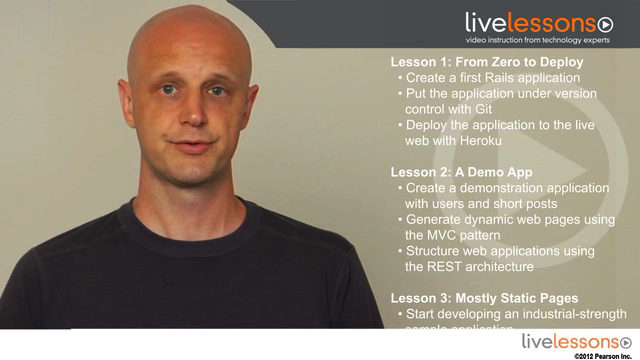Ruby on Rails Tutorial LiveLessons (Video Training): Learn Web Development with Rails, Downloadable Video, 2nd Edition
- By Michael Hartl
- Published Oct 1, 2012 by Addison-Wesley Professional. Part of the LiveLessons series.
Downloadable Video
- Sorry, this book is no longer in print.
- About this video
Accessible from your Account page after purchase. Requires the free QuickTime Player software.
Videos can be viewed on: Windows 8, Windows XP, Vista, 7, and all versions of Macintosh OS X including the iPad, and other platforms that support the industry standard h.264 video codec.
Register your product to gain access to bonus material or receive a coupon.
Description
- Copyright 2013
- Edition: 2nd
- Downloadable Video
- ISBN-10: 0-13-303999-4
- ISBN-13: 978-0-13-303999-3
16+ Hours of Video Instruction
Ruby on Rails LiveLessons Second Edition is the best-selling complete video training course on web development with Rails, the popular web framework for building dynamic, database-backed web applications. You will learn Rails by example by building a substantial sample application from scratch.
Ruby on Rails LiveLessons Second Edition is the update to the best-selling Rails tutorial. The new edition is fully updated for Rails 3.2 and Ruby 1.9 and includes: all-new design using Twitter's Bootstrap; coverage of the new asset pipeline, including Sprockets & Sass; behavior-driven development (BDD) with Capybara & Rspec; better automated testing with Guard & Spork; roll your own authentication with has_secure_password; and an introduction to Gherkin & Cucumber. These focused video lessons help you learn crucial new skills fast– and put them to work immediately! Watch top Rails developer Michael Hartl guide you through building a complete application using today's best practices for MVC and REST design, layout, Ruby coding, security, testing, deployment, and more.
Table of Contents
Lesson 1:
The first lesson teaches how to create a first Rails application. You learn how to use version control with Git and deploy the application to the live web with Heroku.
Lesson 2:
In this lesson you get up and running quickly with a second application that demonstrates the basic workings of a Rails application with users and short posts. It includes a focus on interacting with the demo app through its URIs (sometimes called URLs) using a web browser. You learn how to generate dynamic web pages using the MVC pattern and structure web applications using the REST architecture.
Lesson 3:
This lesson focuses on developing an industrial-strength sample application that will be used throughout the rest of the video. You begin by creating static pages and then adding a little dynamic content. After writing all the code from scratch you develop the sample app using testing and test-driven development (TDD).
Lesson 4:
In a quick detour from building the sample application, you learn about the Ruby language underlying Rails. The lesson also shares how to include an application stylesheet in the sample application, call methods on strings, manipulate arrays and hashes and define custom Ruby classes.
Lesson 5:
This lesson incorporate Twitter’s Bootstrap framework into the sample application, adds custom styles, and fills in the layout with links to the pages created so far. Topics covered include partials, Rails routes, the asset pipeline, Sass and refactoring tests using RSpec.
Lesson 6:
This lesson demonstrates how to create a data model for the site users that also stores the data. You learn how to implement data validations and add a secure password to allow login and authentication.
Lesson 7:
The development of the sample app continues by giving users the ability to sign up for the site and create a user profile. You also learn how to make a signup form with error messages for invalid submission, and implement successful user registration for valid submission.
Lesson 8:
The next task is to develop features for the registered user to sign in and out of the site. You learn how to customize signin status, create a signin form for user authentication, use sessions to allow users to signin, use Cucumber for behavior-driven development, and implement a security model to restrict access.
Lesson 9:
The completed application by the end of this lesson now has a full Rails login and authentication system. You learn how to make a working form for updating user information, implement an authorization system to protect page access, show all users, and with deleted links remove them from the database.
Lesson 10:
This lesson demonstrates how to make a data model for short posts, make a page to show a list of microposts, and implement a web interface to create and delete microposts.
Lesson 11:
The final lesson completes the core sample application by adding a social layer for users to follow and unfollow other users. You learn how to make a data model between users, give users the ability to follow each other through the web, and create a status feed of the microposts from the users.
Bonus:
Installation
Advanced Setup
Sublime Text 2
LiveLessons Video Training series publishes hundreds of hands-on, expert-led video tutorials covering a wide selection of technology topics designed to teach you the skills you need to succeed. This professional and personal technology video series features world-leading author instructors published by your trusted technology brands: Addison-Wesley, Cisco Press, IBM Press, Pearson IT Certification, Prentice Hall, Sams, and Que. Topics include: IT Certification, Programming, Web Development, Mobile Development, Home & Office Technologies, Business & Management, and more. View All LiveLessons InformIT: http://www.informit.com/imprint/series_detail.aspx?ser=2185116
